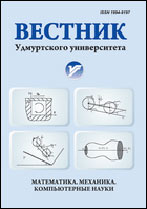|
This article is cited in 2 scientific papers (total in 2 papers)
MATHEMATICS
On tangent lines to affine hypersurfaces
A. V. Seliverstov
Institute for Information Transmission Problems of the Russian Academy of Sciences (Kharkevich Institute), Bol'shoi Karetnyi per. 19, build. 1, Moscow, 127051, Russia
Abstract:
The article focuses on methods to look for singular points of an affine hypersurface or to confirm the smoothness of the hypersurface. Our approach is based on the description of tangent lines to the hypersurface. The existence of at least one singular point imposes a restriction on the algebraic equation that determines the set of tangent lines passing through the selected point of the space. This equation is based on the formula for the discriminant of a univariate polynomial. For an arbitrary fixed hypersurface degree, we have proposed a deterministic polynomial time algorithm for computing a basis for the subspace of the corresponding polynomials. If a linear combination of these polynomials does not vanish on the hypersurface, then the hypersurface is smooth. We state a sufficient smoothness condition, which is verifiable in polynomial time. There are smooth affine hypersurfaces for which the condition is satisfied. The set includes the graphs of cubic polynomials in many variables as well as other examples of cubic hypersurfaces. On the other hand, the condition is violated for some high-dimensional cubic hypersurfaces. This does not prevent the application of the method in low dimensions. Searching for singular points is also important for solving some problems of machine vision, including detection of a corner by means of the frame sequence with one camera on a moving vehicle.
Keywords:
hypersurface, singular point, tangent line, polynomial, discriminant.
Received: 30.01.2017
Citation:
A. V. Seliverstov, “On tangent lines to affine hypersurfaces”, Vestn. Udmurtsk. Univ. Mat. Mekh. Komp. Nauki, 27:2 (2017), 248–256
Linking options:
https://www.mathnet.ru/eng/vuu584 https://www.mathnet.ru/eng/vuu/v27/i2/p248
|

|




 Contact us:
Contact us: Terms of Use
Terms of Use
 Registration to the website
Registration to the website Logotypes
Logotypes








 Citation in format
Citation in format 
